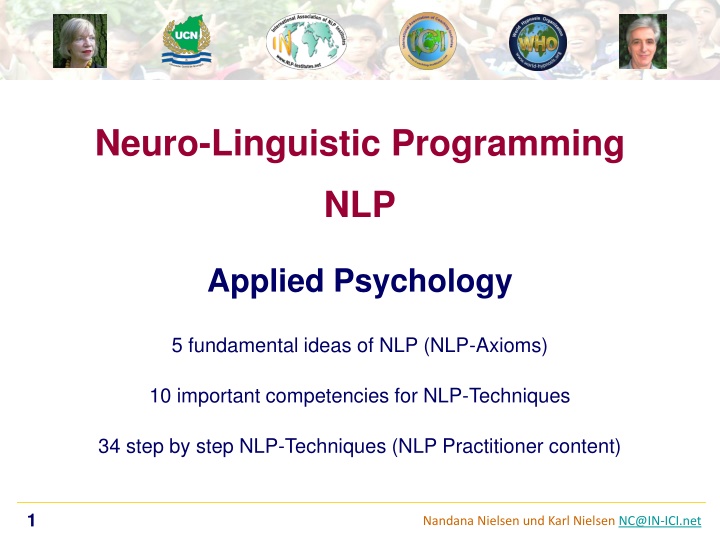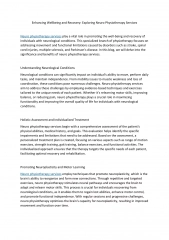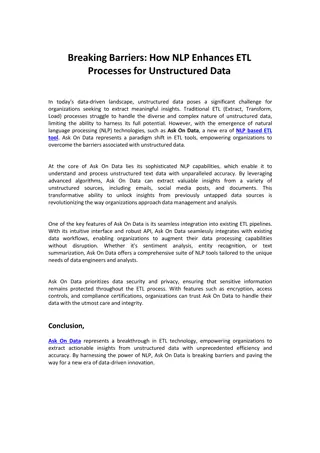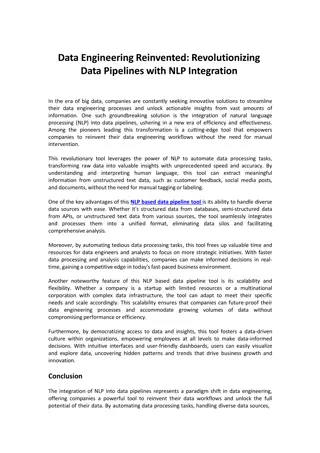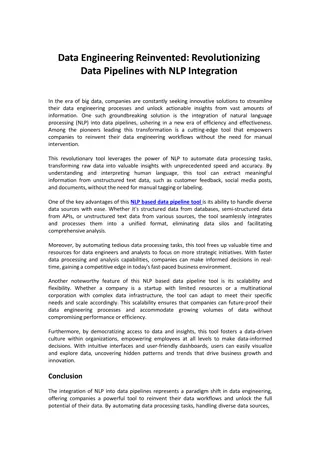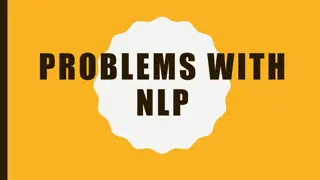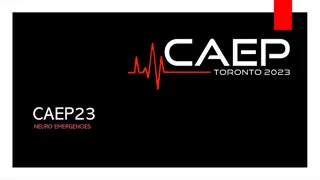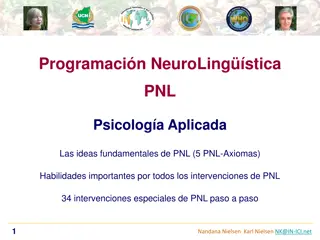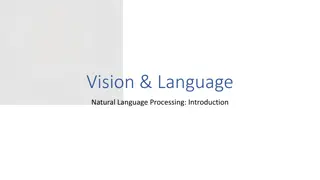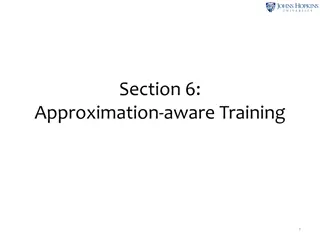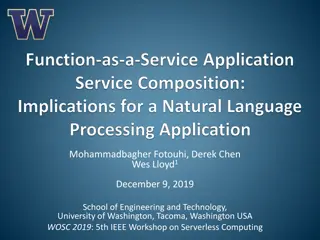Mastering Neuro-Linguistic Programming (NLP) Fundamentals and Techniques
Explore the core concepts of Neuro-Linguistic Programming (NLP) through a comprehensive guide covering essential NLP axioms, competencies, and step-by-step techniques. Authored by Prof. Nandana Nielsen and Prof. Karl Nielsen, this resource introduces the origins of NLP, key principles, and practical skills required for effective communication and personal development. Delve into NLP axioms, basic attitudes, and valuable insights to enhance your understanding and application of NLP methodologies.
Download Presentation

Please find below an Image/Link to download the presentation.
The content on the website is provided AS IS for your information and personal use only. It may not be sold, licensed, or shared on other websites without obtaining consent from the author.If you encounter any issues during the download, it is possible that the publisher has removed the file from their server.
You are allowed to download the files provided on this website for personal or commercial use, subject to the condition that they are used lawfully. All files are the property of their respective owners.
The content on the website is provided AS IS for your information and personal use only. It may not be sold, licensed, or shared on other websites without obtaining consent from the author.
E N D
Presentation Transcript
ICI-Logo IN-Logo Neuro-Linguistic Programming NLP Applied Psychology 5 fundamental ideas of NLP (NLP-Axioms) 10 important competencies for NLP-Techniques 34 step by step NLP-Techniques (NLP Practitioner content) 1 Nandana Nielsen und Karl Nielsen NC@IN-ICI.net
ICI-Logo IN-Logo Card 1: Introduction In NLP, many excellent interventions (techniques) have been developed as step-by-step instructions. We have put together the most important and most effective NLP basic ideas (axioms), NLP skills and NLP interventions (techniques) of the "NLP Practitioner" in this card set. To successfully apply NLP you need: an understanding of the basic ideas of NLP (5 NLP axioms) - see cards 5-6 10 basic skills that are required for all NLP interventions - see cards 7-16. 34 very specific step-by-step NLP interventions (techniques) - see cards 17-50 Prof. /UCN Nandana Nielsen and Prof. /UCN Karl Nielsen are the authors of the present set of cards. They have been trained by the NLP developers, have applied their knowledge since 1985, are the owners of the NLP & Coaching Institute Berlin, Presidents of the International Association of NLP-Institutes" and the "International Association of Coaching Institutes" and as professors have been charged to develop the correspondence course in psychology with a focus on NLP and Coaching (Dr. / PhD) by the Universidad Central de Nicaragua https://www.ucn.edu.ni/posgrados/international-school-of-psychology/ Practice makes perfect, so we ask you to practice these subjects diligently. These cards do not replace an NLP training they are designed to arouse curiosity and allow you to take your first steps in NLP. This card set is a base and an excellent reminder of the important contents in NLP trainings. 2 Nandana Nielsen und Karl Nielsen NC@IN-ICI.net
ICI-Logo IN-Logo Card 2: What is NLP NLP stands for Neuro Linguistic Programming. It is a collection of methods for professional communication, both for meaning oriented intrapersonal communication, and for receiver- oriented interpersonal communication. The inventors of NLP are: Dr. Richard Bandler, Dr. John Grinder, Leslie Cameron-Bandler, Judith DeLozier, Robert Dilts. The first phase of the development of NLP started from 1972 to 1978 at the University of California in Santa Cruz. The NLP inventors modeled: Dr. Fritz Perls (psychoanalyst, founder of Gestalt Therapy), Dr. Virginia Satir (founder of family therapy) and Prof. Dr. Milton Erickson (hypnotherapy), based on the scientific work of William James (cognitive psychology), Alfred Corzybski (general semantics), Gregory Bateson (system theory), Albert Bandura (learning theory) and Noam Chomsky (linguistics). After 1978, NLP users modeled successful communicators from all walks of life: business, psychotherapy, sports, knowledge, education, employee communications, team development, coaching, ... From the results, they have developed NLP methods and step-by-step instructions designed to help people to imitate the skills of highly successful people and discover their own particularity. 3 Nandana Nielsen und Karl Nielsen NC@IN-ICI.net
ICI-Logo IN-Logo Card 3: List of NLP axioms and NLP skills NLP axioms C-5 C 6 NLP axioms: 5 NLP basic attitudes NLP axioms and NLP contents as wisdom NLP skills C 7 C 8 C 9 C 10 C 11 C 12 C 13 C 14 C 15 C 16 Perception and interpretation Rapport with Backtrack and Pacing & Leading Verbalizing emotional experiences Dealing with incongruencies "As if" technique VACOG trance VAC language Eye movement information SCORE Moving from Symptom to Outcome Ecology Check with Future Pace 4 Nandana Nielsen und Karl Nielsen NC@IN-ICI.net
ICI-Logo IN-Logo Card 4-1: List of NLP techniques (interventions) C 17 C 18 C 19 C 20 C 21 C 22 C 23 C 24 C 25 C 26 C 27 C 28 C 29 C 30 C 31 C 32 C 33 1st, 2nd, 3rd Position with others and with a symptom SMART goals Chunking Logical Levels New Behavior Generator Was that the intention of your communication? Intelligent handling of criticism Field of personal excellence and Magic Field Success with TIAUP anchor Anchor merge Visual Squash Change History Context Reframing Six-Step Reframing Submodalities Transfer Praline Format Swish 5 Nandana Nielsen und Karl Nielsen NC@IN-ICI.net
ICI-Logo IN-Logo Card 4-2: List of NLP techniques (interventions) C 34 C 35 C 36 C 37 C 38 C 39 C 40 C 41 C 42 C 43 C-44 C 45 C 46 C 47 C 48 C 49 C 50 Fast Phobia Cure Meta Model 1 - Generalizations Meta Model 2 Cause and Effect Distortion Meta Model 3 - Modal Distortion Meta Model 4 - Lost Performative-Deletion Meta Model 5 - Nominalizations Milton Model 1 - Inverted Meta-Model Milton Model 2 - Go First and Vague Language Milton Model 3 - Embedded Quotes and Prompts Exploring and Changing the TimeLine Ground TimeLine for good experiences Get treasures from the past for a goal Disney Strategy Eye Movement Integration Model the best moments in life Metaphor interventions Metaphor stories 6 Nandana Nielsen und Karl Nielsen NC@IN-ICI.net
ICI-Logo IN-Logo Card 5: What is NLP The basic NLP attitudes are summarized in NLP axioms. These axioms are no truths but success orientations. They are the foundations of NLP interventions (NLP Techniques). Here are the 5 most important axioms: 1. The map is not the territory: People respond to their ideas of reality, and NLP can change these ideas - thus reactions can be changed. Behind every symptom and every behavior lies a positive intention: Every issue contains at least one gift (potential for further development) this axiom changes the mental search direction, people s moods, and increases the probability of success. The intention of your communication is the reaction you get: Change your communication as long as you need to in order to get the desired reactions - this axiom changes the focus from the passive problem consciousness to an activity oriented state of mind. Everything depends on everything else: If you change your thinking you change your emotional state, your perception, your language, your behavior and your interpersonal relationships - this axiom opens the door to change. NLP is systemic, solution-oriented, resource-oriented and ecological- NLP integrates the effects of NLP interventions in an ethically responsible the territory: People respond to their ideas of reality, and NLP can change these ideas - thus reactions can be changed. 2. 3. 4. 5. 7 Nandana Nielsen und Karl Nielsen NC@IN-ICI.net
ICI-Logo IN-Logo Card 6: NLP axioms and NLP contents as wisdom In classical NLP training modules, you will find wisdom specifically applicable in NLP interventions (see C17-50). Self Management: First, always get in a good condition, then many things are much easier to handle, and some take care of themselves. If you do what you've always done, then you will achieve what you've always achieved. Body Language: If you want to understand another person, then try to take their position. Before you judge another human being, first run a mile in their moccasins. Your unconscious permanently comments everything you do by sending emotions. Goals & Motivation: The journey is the goal. Anchoring / Emotion Triggers: If you wish to contribute to peace, then first of all try to find peace inside yourself. It's never too late to have had a happy childhood. Reframing / Reinterpretation: Our lives are shaped not by the events that we go through, but by the meaning we give to these events. Submodalities (see C31): The type of your mental storage determines your behavior. Meta & Milton Model: The way people form their sentences reveals the way they influence their own perception. TimeLine: Time is a matter of choice. Strategies: Only the union of your inner mental forces leads to extraordinary results. Metaphors: Metaphors convey wings to the soul. 8 Nandana Nielsen und Karl Nielsen NC@IN-ICI.net
ICI-Logo IN-Logo Card 7: Perception and Interpretation We perceive reality with our five senses. Every statement should always be examined according to the question whether it contains concrete verifiable perceptions or interpretations difficult to verify. Step sequence in small groups: 1. A tells B: "I perceive in you that.. (you are pulling the corner of your mouth, the skin color turns pale, your voice gets louder ...)". The others make sure that everything that is said is about perceptions. 2. "From this I interpret that you.. (take pleasure, are insecure, afraid, ...)". The others make sure that everything is interpretation. 3. B tells A: "And as you said, I've noticed in you that ..." The others make sure that it is really about perceptions. 4. "From this I interpret that ..." The others make sure that it is interpretation. This step sequence is endless and trains the perception of the difference that makes a big difference. 9 Nandana Nielsen und Karl Nielsen NC@IN-ICI.net
ICI-Logo IN-Logo Card 8: Rapport, Backtrack, Pacing, Leading We adjust our body language to that of other people (rapport). This allows us to understand them better, they feel understood and we can assist them in changing their emotional state and becoming solution- and resource-oriented. This sequence comprises seven steps: 1. Summarize briefly the content of what the other has said (Backtrack) before you respond to that content. 2. Adjust your speaking rate, your voice volume and voice pitch to that of your interlocutor, thus building rapport with the other person s pronunciation. 3. Imitate the posture of your interlocutor (overall body posture, arm and leg position). Mirror-like rapport is strongest most but also very conspicuous. 4. Emulate the gestures and facial expressions of your interlocutor by replicating them with Backtrack. 5. Use the same kind of words as your interlocutor (see C13). 6. Adjust slightly to the breathing rhythm of your interlocutor. 7. Find out if small changes in the way you speak (2) or move (3, 4, 6) are unconsciously imitated by your interlocutor. If you notice Rapport, you have paced sufficiently (adjusted your body language), then you can lead your interlocutor into a better condition. If you change your state he will imitate you automatically. 10 Nandana Nielsen und Karl Nielsen NC@IN-ICI.net
ICI-Logo IN-Logo Card 9: Verbalizing emotional experiences We can amplify the Backtrack (see C8) by paying particular attention to the emotional level of our interlocutor. The fact that we consciously address this level of communication makes it is easier for our interlocutor to open up to this level. Sequence of steps 1. Summarize what the other person has just said and just go along, with particular reference to what resonates emotionally. It is helpful to formulate the contents in a very gentle way. 2. Build a good Rapport with your interlocutor by emulating their body language, their posture, gesture, language and breathing rhythm (see C8). 3. If the body language Rapport is strong enough, you can lead your interlocutor into solution and resource-oriented states. If you change your state they will automatically follow you (see C8) if your Rapport is strong enough. 11 Nandana Nielsen und Karl Nielsen NC@IN-ICI.net
ICI-Logo IN-Logo Card 10: Dealing with incongruencies Your interlocutor s unconscious is your best friend. It permanently communicates with you via the body language. Incongruencies are your interlocutor s unconscious body language clues indicating that something may be different than expressed verbally. Incongruencies reveal your interlocutor s unconscious opinion about what he says. Therefore it is worthwhile to maintain this relationship with the help of NLP. You can use one of the options below and ask the As-if Question: "If there was still something that should be taken into account, what could it possibly be?": Useful interventions before asking the As-if Question 1. Imitate incongruence by using body language backtrack (see K8). 2. Reflect incongruity by using verbal backtrack, for example by asking: "Isn t it? 3. Reflect incongruity by using non-verbal backtrack, for example, generate any incongruity (face warp) 4. Ask directly about the incongruence: "What does your (call body signal) feel about your ...?" This is only possible with very close friends or in coaching / therapy. 12 Nandana Nielsen und Karl Nielsen NC@IN-ICI.net
ICI-Logo IN-Logo Card 11: As-if Questions In some conversations, if your interlocutor says that he does not know or cannot imagine something, we encourage you to try As-if Questions. Sometimes it works wonders and sometimes it does not fit. Variations of the As-if Question As-if of the way: If you want to ask for inner experience during an NLP intervention and you want to know whether something is bright or dark, loud or soft, warm or cool ... and your client and says: "I do not know." it is worth asking, "What comes to your mind first?" As-if of the solution: "If you had an idea for a possible solution to this issue, which could be the best?" As-if of the time: "If you look back from a moment in 10 years, what could you possibly see from that perspective that could be a solution?" As-if of the miracle: "Suppose a miracle would happen, what would probably be different?" As-if of the person: "What could someone else think about it?" As-if of a symbol: "What could a ball / tree / the sun / think about it? " 13 Nandana Nielsen und Karl Nielsen NC@IN-ICI.net
ICI-Logo IN-Logo Card 12: VAKOG Trance In many NLP interventions all senses are activated: sight (V: visual), hearing (A: auditory), feeling (K: Kinesthetic), smell (O: olfactory) and taste (G: gustatory). Often only the first 3 senses are used, and O and G are considered as parts of K. The properties of these sensory areas are called submodalities in NLP. By activating all the senses things are experienced intensely, memories are recalled better, ideas are mentally anchored stronger, and learning is facilitated. Examples of VAKOG submodalities V: color, brightness, size, location, shape, intensity, A: sound/melody, volume, theme, word, sentence, K: sensation, respiration, temperature, motion/rest, weight, gesture, O: fresh, fruity, flowery, like a particular perfume, ... G: spicy, mild, sweet, tasty, ... 14 Nandana Nielsen und Karl Nielsen NC@IN-ICI.net
ICI-Logo IN-Logo Card 13: VAK language In NLP, we pay special attention to the sensory channels that our interlocutor uses when expressing himself. When speaking, we try to use the same sensory channel as our interlocutor, and thus enhance mutual understanding. Rarer variations in smelling (O) and taste (G) are expressions like: "That doesn t go down well with me." or "He smells a rat." Examples of VAK expressions V: look at, evocative look, sparkle, view, horizon, obviously, ... "Overview brings clarity and insight. Look how many clues you can find if you keep your eyes open." A: answer, discuss, ask, listen, sound, calm, translate, shrill, silent, say, agree, mood, harmony, ... "It's not what you say, but how you say it. to be in accord with something . If that came to his ears " K: work, treat, press, firm, fit, run, soft, wear, position, in control, grab, ... "That s a piece of cake, in the twinkling of an eye, you assemble some more notions, and you feel comfortable." V is often accompanied by rather fast talking, high speech tone, upright posture, and fast gestures, A by melodic speaking, and K by a rather deep speech tone and slow abdominal breathing and speaking. 15 Nandana Nielsen und Karl Nielsen NC@IN-ICI.net
ICI-Logo IN-Logo Card 14: Eye movement evidence Eye movements provide clues to the sensory channel people use. You can adjust to them by using words from the same sensory channel. This will also train your attention and your perception. Vre= Visually remembered (internal images) Vc= Visually constructed (internal images) Are= auditory remembered (listen) Ac= Auditory constructed (listen) AID= Auditory Internal Dialogue (conversation) K = Kinesthetic (emotions) Posture, breathing, gestures and VAK language (see C13) provide additional hints to the sensory channel people use. 16 Nandana Nielsen und Karl Nielsen NC@IN-ICI.net
ICI-Logo IN-Logo Card 15: S.C.O.R.E. SCORE is a proven sequence of questions designed to find out about your interlocutor s mental map when problems arise, and to professionally move from the problem towards the desired goal. Even if it is obvious that the other person ascribes their problem to the wrong reasons, we must be aware of the fact that it is anchored in their thinking, and thus we learn at which point we can meet them. So in order to make sure you understand your client correctly, we recommend that you backtrack at every step and look out for matching agreement. Step sequence 1. Symptom: find out about the problem: "What exactly is it about?" 2. Cause: find out about the cause: "Where did the problem originate?" 3. Outcome: "What would you like to achieve in this situation?" (see SMARTe C18) 4. Resources (for example, skills, time, money ...): a) already existing resources b) required resources 5. Effect: "Which implications arise when you have achieved your goal?" (see Ecology C16) SCORE is suitable for preparing an NLP intervention. It can also be used as a continuous improve- ment process for employee survey. SCORE is sometimes all it needs to produce the desired change. 17 Nandana Nielsen und Karl Nielsen NC@IN-ICI.net
ICI-Logo IN-Logo Card 16: Future Pace and Ecology Check NLP is systemic, and in all NLP interventions we need to integrate the relationships and impacts (Ecological check) by asking the client at the end of each NLP intervention to imagine the future (Future Pace). We pay special attention to incongruencies, which are positively reframed (reinterpreted) and used as unconscious objections (see K10): "If there was something left to consider, what might that be? Future Pace: Imagine the impact of a change in the future. Ecological check: Ask the client how specific developments fit to his person, to his life, and his environment. Ask for possible implications and consequences and pay attention to incongruencies. 18 Nandana Nielsen und Karl Nielsen NC@IN-ICI.net
ICI-Logo IN-Logo Card 17: 1.2.3. Position This NLP intervention is a further development of the "hot chair" of Gestalt therapy. The intervention starts with a conflict a person has with someone (B) or symptom a person suffers from (B). If you only try to figure out the situation in your thoughts, you will only get about 3% of the possible information. Sequence of steps 1. Take the first position: How do I feel there? What do I think about the other person (or the symptom)? 2. Imagine the other person (or the symptom) on a second chair, using the "VAKOG" technique (see C12). The more intensity you can achieve, the better it is for this intervention. 3. Talk directly to the other person. Tell them what you think of them. Watch for their reaction. 4. Now switch places. Take the second position. How does it feel there? Explore this position. 5. Look at the person in the first position. Talk to him or her. 6. Now you can switch several times between the two chairs and give an answer from every position. 7. Go to a third position from which you can see the two other positions. Which aspects have escaped you in the first and the second position? 8. Integrate the findings into the other positions by moving back in there. 9. Make a final check on Future Pace ecology (see C16). 19 Nandana Nielsen und Karl Nielsen NC@IN-ICI.net
ICI-Logo IN-Logo Card 18: SMART goals The journey is the destination. Scientific research confirms that those who mentally enhance their motivation on the way to the goal are much more successful than those who only intensify their visualization of the goal. Therefore, we focus on the goal-oriented forces that can accompany us on the road. Sequence of steps Specific situation: Write down your first goal. The words you use shoud not contain any negation or comparison. Then look at the visualization of the target situation. Which are the faculties you need to develop in order to get to the destination? The goal we want to achieve here is the deployment of these faculties. Measurable: How can the development of the required faculties be measured objectively? Attractive: Intensify the attraction of these forces by using the VAKOG questions (see C12). Realistic: Make sure that the final goal and the goal of each step can be reached by your own endeavour. Timed: When exactly does the final goal and the goal of each step need to be achieved? Ecology: Mind the system ecology: What are the possible impacts of the goal when you have reached it? Pay special attention to incongruencies (see C10). 20 Nandana Nielsen und Karl Nielsen NC@IN-ICI.net
ICI-Logo IN-Logo Card 19: Chunking - up, down and sideways To chunk up means to ask for the higher level of something. Monetary targets for example often stand for the things somebody would like to buy, and in turn, by possessing certain things, people often hope to achieve a sense of well-being. Chunk sideways enhances motivation by activating the right hemisphere. Chunk down creates precision on the basis of chunk up and chunk sideways. Sequence of steps 1. Apply the two chunk-up questions to a target: "What would you achieve if...?" and "What do you want to achieve?" If possible, repeat these questions several times. 2. Intensify the higher goal by chunking sideways: "To achieve this goal is for you like ... (what)?" Here we are looking for motivational metaphors and referencial experience. 3. When chunking down, you ask: "When, with whom, by which means and how exactly do you want to do this? What exactly do you need to do in order to get there? And what else? And what else?" Chunk sideways can also be used in smalltalk situations in order to change the subject of the conversation by referring to something the other person has said and responding with: "This reminds me of ..." Chunk up can also be used in stalled negotiations and for finding the ethically acceptable goal behind unethical aims. 21 Nandana Nielsen und Karl Nielsen NC@IN-ICI.net
ICI-Logo IN-Logo Card 20: Logical Levels The pulling force of the goals can be greatly enhanced by the Logical Levels. By adding the universe and a symbol, even more creative levels are activated. In the original form developed by Robert Dilts, the level called vision comprises the universe and the symbol . Sequence of steps 1. In what kind of environment do you imagine to realize your goal? 2. What kind of behaviour do you show? 3. Which skills do you use? 4. Which beliefs and values does your goal incorporate? 5. How do you define your identity in the process? 6. Now look up and left. Imagine the universe there (allow time for it). Now move two steps forward, turn left and step into the universe. Become the universe. Explore the situation from the position of the universe. Give yourself a recommendation. Send this recommendation to the identity level. Go back to the identity level and receive the recommendation. 7. Now look to the right. Let there arise a symbol. Move two steps to the right, to the front ... Keep it up the way you did at the universe level: take the position of the symbol, enquire its message, send a recommendation and receive it at the identity level. 8. With this new energy now move back all the steps to beliefs and values, skills, behavior and environment, and see how this energy affects each level. 22 Nandana Nielsen und Karl Nielsen NC@IN-ICI.net
ICI-Logo IN-Logo Card 21: New Behavior Generator Basically, the New Behavior Generator is a New State Generator - it creates a new state that allows a new behavior. In this NLP intervention, many NLP skills are included. Sequence of steps 1. Take a SMARTe goal and define each step to the goal (see C18). 2. Imagine yourself a few feet away, as you develop your skills that will lead you to your destination. In what kind of environment do you see yourself? What kind of situations trigger the development of these faculties? Which values and beliefs come true here? 3. Intensify this idea by using VAKOG (see C12). This kind of dissociated imagination helps to activate your motivation. 4. Then you go to the place where you saw yourself and stay there. Experience and enjoy it. This associated imagination increases your belief in your ability. 5. Does everything feel completely right? Are there any incongruencies (see C10)? If there is something left that needs to be changed, then go back to 1., change the formulation of your goal accordingly and repeat the whole sequence. 23 Nandana Nielsen und Karl Nielsen NC@IN-ICI.net
ICI-Logo IN-Logo Card 22: Was this the intention of your communication? This is an advisory or coaching intervention used for situations in which your interlocutor complains about someone behaving inappropriately towards them. Thanks to NLP you are immediately able to modify your behavior if the person responds differently from what you expected: Change your behavior until the reactions go in the desired direction. Sequence of steps 1. Steer the conversation to the point where your interlocutor says that the person about which he complains, reacts inappropriately. 2. Then you ask: "Which reaction would you like to get?" 3. Use Backtrack (see C8), and then ask: "How do you need to behave in order to get the desired reaction?" 4. Now you can imagine yourself using the new behavior, and practice it with role-play. (In order to facilitate the use of the new behavior, you can additionally use NBA (see C21) and 1.2.3. position (see C17). 24 Nandana Nielsen und Karl Nielsen NC@IN-ICI.net
ICI-Logo IN-Logo Card 23: Dealing with unfair criticism Between stimulus and response lies a gap. You can enlarge this gap using NLP. The following NLP intervention can be applied if someone criticizes you unfairly. If you are rightly criticized, you just apologize and try to correct your behavior with your interlocutor s help. Sequence of steps 1. Save time Part 1: Only say two words, e.g. "Oh yes.", or "Oh!" or "Well, well.." This gives you time to think. Step a little to the side, so that the attack energy can flow past you. 2. Part 2: Use the question form of Backtrack (see K8), e.g. with: "Have I understood you correctly that you mean,..." Perhaps this already clarifies the situation. 3. Part 3: You pay tribute to their critics, e.g. with: "Thank you for addressing this so openly and directly. You are obviously interested in finding a solution." 4. Part 4: Apologize without apologizing by saying something like: "I'm sorry if I...you with " That calms down many attackers, even though you haven t admitted anything. 5. Now you have saved enough time and can pass on to the attack if you want, e.g. by saying: "I understand that you see that this way from your point of view." or, "What exactly would you like me to do now?" 25 Nandana Nielsen und Karl Nielsen NC@IN-ICI.net
ICI-Logo IN-Logo Card 24: Energy Field of personal excellence and Magic Field Sequence of steps 1. Try to remember a situation in your life in which you felt particularly excellent, completely fine, where you were in the flow, in line with your emotions, your values... Remember emotional details as intensively as possible. 2. If you would see a field of energy 2-3 meters in front of you now that expresses exactly this mood, what color would it have? What sound would it have? What kind of energy can you see there? (Submodalities see C31) 3. Do this with at least two other past resourceful states and intensify the energy field on and on. 4. When the energy field has become really intensive, step into this field and enjoy it. While standing in the field, see how the power intensifies even further. 5. Step in and out for a few times. Look at the energy field from outside and experience it from within. It is your field of personal excellence. 6. Think about future situations in which you can use this energy field. 7. Find a name for this field of energy, connect it with a little movement and get used to your energy field in the next time. Practice repeatedly to let it arise, and step into it. Then this tool will be available to you even in challenging situations. Magic Field: You can use a variation where your unconscious shows you the magic energy field that it considers best for you. Instead of 1 you ask your unconscious to let emerge in 2-3 meters before you a field of energy that would be very good for you and your further development to experience. Skip 2. Everything else is the same. 26 Nandana Nielsen und Karl Nielsen NC@IN-ICI.net
ICI-Logo IN-Logo Card 25: Success anchor The success anchor is a pile anchor that connects positive experiences from the past with a selected location on the body. If you build this anchor well, it will serve you in critical situations. Sequence of steps 1. Pick a spot on the body that you want to use as "anchorage". 2. Now remember a powerful experience in all sensory channels (see VAKOG C12). 3. Once the memories unfold and you can feel them intensely, touch the selected spot on your body. 4. Do this with several powerful memories. 5. In critical situations you make the same movement to restore this state of power. 6. In order to remember what really matters when anchoring you can use the acronym TIAUP. Timing: If you anchor just before the unfolding of your memory has reached its climax, you can use the dynamics of the inherent movement as well. Intensity: Using all VAKOG channels increases the effectiveness. Accuracy: The memory and the emotion stored in an anchor can be best recalled when the anchor is stimulated in exactly the same way as it was set (same location, movement, pressure, ...). Uniqueness: The spot on your body at which you want to anchor an emotion should not be already occupied by strong memories. Purity: Whatever you think about when anchoring will be anchored along with the intentional anchor. 27 Nandana Nielsen und Karl Nielsen NC@IN-ICI.net
ICI-Logo IN-Logo Card 26: Anchor merge An anchor merge is an NLP intervention designed to set and test two emotional states as anchors, and then to activate them simultaneously or in quick succession. NLP is change of one s state of mind. In certain states of mind, we only have limited behavioral options at our disposal. Anchor merging enables us to extend our behavioral options. Sequence of steps 1. Activate a negative anchor with VAK, anchor it on a spot on your body, and test it. Here, a separator is not required since this sequence will not be changed afterwards. 2. Activate a positive anchor with VAK, anchor it on a spot on your body, and test it. (you may use staple anchors, see C25). 3. Separator: use an interruption or a distraction. 4. Enable both anchors simultaneously or in succession (first enable the negative, then the positive anchor), and mix both anchors. Trance language is helpful here (see C40- 42). 28 Nandana Nielsen und Karl Nielsen NC@IN-ICI.net
ICI-Logo IN-Logo Card 27: Visual Squash This NLP intervention is best used for people who have internal conflicts and who can visualize very well. Sequence of steps 1. Both hands are open with the palm up. Visualize a part of the conflict on each hand: "What does this part? What kind of voice does it have? How much does it weigh? - What does the other part, on the other hand, look like? ... " 2. Every part can tell what it is about. You may have both talk to each other in their usual way. 3. Each part of the conflict expresses its positive intent. The other part of the conflict appreciates the first part and its positive intent. 4. Place a resource for understanding in the middle between the two hands e.g. a cloud, a meadow, a haven ... 5. Accompany the integration of the two hands with comments. Trance language (see C40-42) is very helpful here: "And if you allowed your two hands to move slowly towards each other, and you need not know how it happens..." 6. If objections arise, reframe them as a positive intent and then integrate them. 29 Nandana Nielsen und Karl Nielsen NC@IN-ICI.net
ICI-Logo IN-Logo Card 28: Change History It's never too late to have had a happy childhood. From inside of us, "inner children" watch what is happening out there, and react. As they sit at the emotion lever, these reactions are often very intense and inappropriate. This NLP intervention provides resources for our "inner children". Sequence of steps 1. Problem: Recall a disruptive initial feeling with associated VAK trance (see K13) and try to find a movement of your hand for it. 2. To the source: Let the hand movement associated with the problem withdraw you mentally into the past. Explore the intermediate stations and the origin. 3. Talk with your inner child at the origin of the problem, starting with something like: "I'm from your future". If your inner child distrusts you, you may try to build trust by showing the child, for example, that you can make the room brighter, etc. Use magic tricks for building trust. 4. Resources: Give the child everything it would like to have (toys, stuffed animal, ...). Clarify responsibilities: "You live in me, and you can relax and feel comfortable here. I am responsible for what happens outside. I will also be happy to be there for you. If you need me, I'll come to you. I'm happy about you . Do this until a wonderful feeling arises. 5. Enable solution resource: Express your new state of mind in a movement of your hand. 6. Supply the intermediate stations and use Future Pace: Move through the intermediate steps with this hand movement. You can also confront future situations by making this hand movement. 30 Nandana Nielsen und Karl Nielsen NC@IN-ICI.net
ICI-Logo IN-Logo Card 29: Context reframing Some reactions do not make sense in some contexts. This NLP intervention helps to find the original context of the reaction, thus enabling you not to use the disabling reaction in current contexts. In this NLP intervention, we use small pieces of paper ("point A", "V1", ...) that we lay on the floor as anchors. Sequence of steps 1. Description of the problem behavior "V1" in the current context A at the "Place A" (designate a place A in the room). Show the problem behavior "V1" by using body language (use VAKOG, see C12). 2. Move around in the room, find the original context B for behavior "V1", and designate "location B". Connect "V1" to "point B" (original context): "It belongs right here." 3. Designate a place for the meta-space "Location C" and, standing in the meta-space, imagine the new desired behavior "V2" at "position D" in the room. 4. Activate the desired behavior V2 in an associated way at "Place D and send it from there to" Place A", accompanied by its specific color, sound and movement. 5. Receive the solution behavior at "Place A" and try it mentally in context A. 6. Ecological check using Future Pace (see C16): Imagine a future situation and watch for incongruencies (see C10). 7. In order to find more solutions for the problem behavior displayed at "point A", we recommend the NLP intervention "Change History" (see C28). 31 Nandana Nielsen und Karl Nielsen NC@IN-ICI.net
ICI-Logo IN-Logo Card 30: Six-Step Reframing This NLP intervention is suitable for treating unexplained symptoms and fears. It requires a lot of NLP experience. Sequence of steps 1. Clarify the problem with SCORE (see C15) and thereby sow ideas, such as: "The unconscious is your friend. It manifests itself through body sensations. The manifest behavior and the underlying intent may be very different ... " 2. Establish a communication with the unconscious: "Where in your body do you feel this problem? Put your hand there and welcome this part of yourself that has shown up there. Ask this part of yourself to increase briefly what you feel, just as a sign to let you know that it is willing to communicate with you . 3. Ask this part: "What is the positive intention that you want to realize with the problem behavior?" Ask it to send a sign, so you know that you have understood it correctly. 4. Ask this part to meet the creative part in you and to find three new ways of behavior for the implementation of its positive intent, which are in agreement with all other components of your personality. Ask for a sign of confirmation every time you have found a new behavior. 5. Make an ecological check with Future Pace (see C16). 6. Ask this part to send you a sign, so you know that it is ready to take responsibility for the new behavior. 32 Nandana Nielsen und Karl Nielsen NC@IN-ICI.net
ICI-Logo IN-Logo Card 31: Submodality transfer In card 12, submodalities are explained as sub-properties of the 5 senses. Properties in the visual field are for example: color or black and white, light or dark, large or small, near or far, ... The emotional reaction we connect to a memory or to an idea does not depend on its content, but on the internal representation of the properties. These properties can be changed by means of NLP. Whether we are afraid of something or happy, motivated or not, depends on the nature of our inner imagination. Sequence of steps 1. Ask your interlocutor to remember an uncomfortable experience. Find out about the most important submodalities of the internal representation of the memory. V: Image or film, color or black and white, light or dark, associated or dissociated, where is it located in the room,...? A: monotonic or melodic, loud or soft, from near or far, ? K: heavy or light, with or without movement, location and nature of the correspondent body sensation, ? 2. Then ask the same questions to find out about the most important submodalities of a wonderful experience. 3. In which submodalities do these two memories differ? 4. Change the effect of the unpleasant experience by asking your interlocutor to transfer the submodalities of the wonderful experience to the unpleasant experience. 5. Clarify the ecology (see C16). 33 Nandana Nielsen und Karl Nielsen NC@IN-ICI.net
ICI-Logo IN-Logo Card 32: Praline format This submodality format is well suited to build motivation for things you do not like to do. Associated means that you see something the way you usually see it through your eyes. This creates the feeling that something can be. Dissociated means that you see yourself from outside. This creates the feeling that you want to go there. Sequence of steps 1. Get inside an associated picture of something you irresistibly like (e.g. chocolate). Place the picture to the side in your imagination. 2. Create a dissociated picture of yourself as you do something you would like to be more motivated for. 3. Clarify internally whether it is okay for all inner areas that you enjoy doing the job. 4. Imagine the dissociated image 2, and directly behind it the first motivational associated image. Make a small hole in image 2, so that the first image becomes visible behind it. Make the hole several times larger and smaller. 5. Now look at image 2 again and experience its new effect. 34 Nandana Nielsen und Karl Nielsen NC@IN-ICI.net
ICI-Logo IN-Logo Card 33: Swish This submodality intervention is a good way to change unwanted behavior. Sequence of steps 1. Associated problem image: Concentrate mentally on what triggers the unwanted behavior. Make the image a square and build a frame around it. 2. Test whether shrinking and darkening it weakens the effect. 3. Dissociated target image: See yourself in a new image, displaying the new behavior. 4. Test to see if magnification and more brightness intensify the effect of the target image. 5. Clarify internally whether all inner areas agree to make this change. 6. Make the problem image big and bright. 7. Make the target image small and dark and place it in the lower right corner of the problem image. 8. Swish: Let the small dark image quickly become large and bright, while the problem image behind it shrinks, fades and then disappears. 9. Delete the image mentally, open your eyes and look around (separator). 10. Repeat the Swish several times, getting faster every time. 11. Test: Imagine the first picture now. If it comes with some difficulty, then the Swish intervention worked. 12. Alternatives: Instead of brightness and size, you can use distance and color. For further support, you can take each picture in one hand, and when saying Swish , move the target image quickly to the front while pushing the problem image back. 35 Nandana Nielsen und Karl Nielsen NC@IN-ICI.net
ICI-Logo IN-Logo Card 34: Fast Phobia Cure This submodality intervention is well suited for treating fears of lifts, aircrafts, dogs, .... Sequence of steps 1. Imagine yourself sitting in a movie theater and seeing a photo of yourself on the screen, in a situation before the situation arose that triggers your fear, when everything was still okay. You know that on the opposite side there is a photo of you after the fearful situation, when you were safe again. 2. Now imagine seeing yourself from the perspective of the projection room, sitting in the cinema as you look at the screen and you view the film in black and white, from the point of "everything okay", through the fearful situation, until the moment you feel "safe again". 3. Now fly out of the projection room, straight into the final image of "safe again" and let this final image be colored in your mind. 4. Experience physically how the whole movie in color now runs back to the initial situation very fast, where everything is still okay. At this point, you let the screen turn white, and then open your eyes. 5. Experience step 4 several times, getting faster every time. 6. If you no longer know the original triggering situation, you can go through steps 1.- 5. imagining three different situations otherwise, the original situation will do. 7. Shortly after the intervention, try its effect mentally and in a real life situation. 36 Nandana Nielsen und Karl Nielsen NC@IN-ICI.net
ICI-Logo IN-Logo Card 35: Meta-Model 1 - Generalizations (Universal quantifiers) The meta-model examines sentences, looking for disabling generalizations, distortions or deletions. The meta- model questions are used to restore the apparent lost portion of experience in the debilitating sentence. By using generalizations (always, never, all ...), we avoid the singularity and depth of an experience. The result is boredom. Anyone who has the habit of generalizing has chosen superficiality, at least in one particular area. The meta-model questions are used to change the perception filter. When you hear that your client uses generalizations concerning a particular subject, then the following questions may help him change his perspective. It is also worthwhile to look for generalizations in your own inner monologue, and possibly use this NLP intervention. Sequence of steps 1. Simply end the generalization on a questioning tone: "All teachers"? "Always"? "Never?", "All"? "Every?", "All NLP practitioners?" 2. Ask about or invent a counter-example: "Don t you really know anybody who ...", or "I know ... " 3. 3.If it is fitting, ask for specifications: "Who exactly do you mean?" You'll be amazed about how often you will hear very specific names. 4. A provocative variation is to respond with even more universal quantifiers, exaggerating, e.g.: "Aren t we all always like that everywhere?" 37 Nandana Nielsen und Karl Nielsen NC@IN-ICI.net
ICI-Logo IN-Logo Card 36: Meta-Model 2 - The Cause and Effect distortion People love to invent reasons, e.g.: "Because of ... (X) that s why I'm ... (Y) ". There are supportive beliefs and debilitating beliefs. We recommend to replace limiting beliefs by supportive beliefs. Beliefs typically have the form: "As X, therefore Y." By nurturing disabling convictions we avoid taking responsibility. Often disabling convictions hide power, dependence, sacrifice, guilt, anger and aggression. We often choose to feel at the mercy of something or somebody, make ourselves small, we choose confusion and accusations. With the following NLP intervention you can question limiting beliefs and offer supportive beliefs instead. As such beliefs are rooted emotionally, logic doesn t help in most cases changing beliefs requires significant emotional irritations. Sequence of steps 1. Expose the reasoning of cause and effect: "What exactly causes ... (X) ... (Y)?" 2. Irritate the reasoning: "Where is the connection?", or "What does the one thing have to do with the other?" 3. Question the generalization: "Does X always mean Y?" or "Is it always like that when ...?" 4. You can also provoke on an emotional level: "What makes you think that?", or question the generalization contained therein: "Is it always like that?" 5. If your interlocutor shows an emotional irritation, you can offer a helpful alternative: "Is it not rather the case ..." 38 Nandana Nielsen und Karl Nielsen NC@IN-ICI.net
ICI-Logo IN-Logo Card 37: Meta-Model 3 - Modal operators (should, must, cannot) Modal operators (should, must, can not ...) hint at the fact that someone relies on external authorities. People using modal operators usually avoid responsibility. Behind it usually lies overstraining and emotional pressure. Those people often have chosen helplessness, adjustment, repression and identification with the aggressor as their behavioral response. This intervention is suitable only for statements which do not contain an explanatory statement. In: "You always have to help everyone" (deletion), the reasons why you have to do it is missing. Sequence of steps 1. Ask: "What would happen if ... (they would not always help everyone)?" or "What prevents you from ... (also thinking about yourself) ?" Then you will usually get the missing part of the underlying conviction, the cause and effect link. Now continue with the questions from K36. 2. In a therapeutic context you can also ask: "Who said that actually?" This variation is useful if you think that someone else has, in part unconsciously, set standards. If your client says, "My mother," then you ask him: "You always do everything your mother tells you to?" 39 Nandana Nielsen und Karl Nielsen NC@IN-ICI.net
ICI-Logo IN-Logo Card 38: Meta-Model 4 - Lost Performative The Lost Performative ("It is true, good, wrong. ...") implies a judgement in which the agent (Performer) has been lost or left out for unconscious reasons (deletion). The judgement thus appears more objective. Behind it often lies dominance/subordination and lack of flexibility. People expressing these judgements have chosen helplessness, adaptation/suppression and identification with the aggressor as their pattern of behavior. Unrelated comparisons ("That's too expensive, heavy and,...") and clairvoyance ("He knows exactly what I think about it.") fall in this same category. By means of the meta-model questions you can take out the mist from the judgements and open a way for new decisions. Sequence of steps 1. Ask: "From which standpoint?" 2. "Judged by what standard?" 3. "How do you know that this is so?" 4. "Regarding what ...?" 40 Nandana Nielsen und Karl Nielsen NC@IN-ICI.net
ICI-Logo IN-Logo Card 39: Meta-Model 5 - Nominalizations and nonspecific verbs Nominalizations (hope, freedom, fear, shame) are verbs (processes) that have been transformed into nouns (objects). An act was turned into a thing, and thus solidified. This makes the act appear larger and more important. In this case, you can ask questions trying to get your interlocutor to think about an activity: "What exactly do you do if you hope / feel free / ashamed /worried...?" or: "What exactly does mean to you? or: "How did you know that you ...? (and continue with an undertone of doubt) Couldn t it be that you feel...? " When you are dealing with unspecific verbs, try to find the lacking specific information: "How exactly ..."," What exactly ...?" The statement: "I am a smoker" consolidates the act of smoking at the identity level. The question: "What exactly do you do as a smoker?" may lead to the answer: "I smoke a cigarette every day." Now it's just a behavior. Behavior can be changed more easily than identity. In nominalizations and non-specific verbs, all three processes are obvious: generalization, distortion and deletion. If they limit a person's life, we call them meta-model distortions and work with the meta-model questions to find an alternative to the limiting expression. In the Milton model (see K40- 42), we use them to induce a trance. 41 Nandana Nielsen und Karl Nielsen NC@IN-ICI.net
ICI-Logo IN-Logo Card 40: Milton Model 1 - Inverted meta-model verbs The Milton model is named after Milton Erickson. It consists essentially of the inverted meta-model (see C35-39), vague language, embedded prompts and special trance instructions. Trance is a state produced by hypnosis. In the inverted meta-model we use the meta-model violations as hot air, which means that people go into trance states. Generalizations: all, you always, nothing, people ... Correlations: before, and while, then, by making, which leads to ... Modal operators: (must, may, can) you do not need to do it immediately, you can allow yourself to, it's possible, you are able ... Ratings: it's good, right, makes sense ... Non-specific verbs / nouns / nominalizations: lightness, freedom, let experiences happen, feel ... Example: "Everyone knows even before he thinks and as he opens up, that they can afford and that it is correct to follow their own rhythm, the lightness and joy that leads to the fact that the experience becomes deeper with every breath as you follow my words and you need not close your eyes immediately or go into a deep trance, because it is better to feel at ease and to follow your own thoughts step by step... " 42 Nandana Nielsen und Karl Nielsen NC@IN-ICI.net
ICI-Logo IN-Logo Card 41: Milton-Model 2 - Vague language and Go First Vague language is hot air, which allows the trance instructor to say nothing and help the person who is being initiated to go into a trance. Go First means that it is best if the instructor goes himself into the state in which he wants to lead the other person. Then his condition is being communicated in his words. Example: "Maybe you just want to follow your own thoughts first and it may be that you feel completely inside yourself or maybe somewhere else and as you inhale and exhale, the breath will help you, without you needing to know how that works, to experience a deep sense of well-being or something else that you can enjoy, and I ask you to take your time for this kind of your very own experience ... " If you can use these language patterns at will, you will notice how often they are used quite unconsciously in all sorts of business contexts and everyday life situations, and how often people speak sentences that have no real content. This is often the case especially in official speeches and addresses held by business leaders. And you can afford to practice it so that you can use it deliberately where it is useful, to continue negotiations or to achieve better results. 43 Nandana Nielsen und Karl Nielsen NC@IN-ICI.net
ICI-Logo IN-Logo Card 42: Milton-Model 3 - Embedded suggestions Embedded suggestions in the Milton-model are accentuated by body language and covertly distinguished from the other parts of the sentence by using another speaker direction, volume or emphasis. Business Example: I would not say: "Change your attitude," because I know I m not in the position to say soemthing like that, I'm rather wondering how "you contribute to a common solution" if you want to decide that completely on your own, and perhaps you know that some people say, completely unjustified, "You are to blame if there is again no result," although this is not really true. Trance Example: I would not say, "Now go into a deep trance," because I know that everyone has their own way and I wonder how "relax here and now" while listening to my words, and maybe you know it, if you move "deeper and deeper" in an elevator and your mind starts straying pleasantly. Example Uncle John: My uncle John used to say: "Try hard and study diligently", and knew that he himself had done so with great success. My aunt Emma, however, never said: "You have to make sure that you do it regularly," because she knew how much I loved my freedom. 44 Nandana Nielsen und Karl Nielsen NC@IN-ICI.net
ICI-Logo IN-Logo Card 43: Explore and modify TimeLine There are three classical TimeLine types: ThroughTime people perceive past, present and future as lying in front of them, InTime people see the past as being behind them, the present as going through their body and the future as lying ahead, BetweenTime people perceive the presence as being in their body, and the past and the future before them. Sequence of steps 1. Remember an event that occurred today. If this memory was located in the room, where would it be? 2. Do the same with an event that occurred "yesterday", "a week ago," "one month ago", "one year ago". 3. Do the same with an event that will happen "tomorrow", "in one week," "in a month , in a year." 4. Now experience the present moment. Is it located in your body or in front of your body? 5. Experiment with the two TimeLines with which you did not identify. Train your flexibility. With ThroughTime you can organize your schedule better and are in a better position to use resources of the past. With InTime you will experience the present more intensely and build a closer contact with other people. 45 Nandana Nielsen und Karl Nielsen NC@IN-ICI.net
ICI-Logo IN-Logo Card 44: Ground Timeline for good experiences This intervention is designed to familiarize with the work on the TimeLine and intensifies positive experience. Sequence of steps 1. Designate a place for the present and - according to your inner sense of time for the past and the future. 2. Connect these places on the floor with a cord. Mark the locations with slips of paper. 3. Choose a topic you would like to explore, for example: holidays, birthdays, joy, recognition ..., choose a theme that incorporates positive experiences. 4. Associated exploration: move along the time line from the present into the past by taking small steps backward. Stop when an event or a feeling appears that is related to your topic. Explore this experience with VAK. 5. Dissociated exploration: Move next to the time line from the present into the past by taking small steps backward. When an event appears that is related to your topic, look at it as if you were watching a movie. Mind the submodalities of images and sounds. 6. Alternating exploration: in case of critical events, you can leave the time line by moving to a meta position and then return to the time line at a point that is located before the critical event. 46 Nandana Nielsen und Karl Nielsen NC@IN-ICI.net
ICI-Logo IN-Logo Card 45: Treasures from the past for a goal This intervention is well-suited to activate resources that will support you in reaching a goal. Sequence of steps 1. Set your TimeLine (see K43) with a thread of wool on the floor and determine where past, present and future are located. 2. Choose a goal for which you want to activate your energy. Place the goal on the TimeLine in the future. Stand on the present. Look at yourself (dissociated) standing in the goal position. 3. Look at the past and ask your unconscious mind to remember the skills that will strengthen your goal. 4. Move along the timeline into the past. With every step you take you are getting younger. Collect 3 beautiful experiences that will contribute to strengthening your goal. Pause at each experience. 5. Intensify the beautiful experience represented by the first place with VAK (see K13) with an accompanying gesture. Turn toward the present. Go through all the beautiful memories and connect them with the gesture. Go to the finish line (the goal), repeating the gesture. Enjoy your state of mind and the fullness of your treasures. 6. Go back to the present and see yourself in your goal endowed with this new quality. 47 Nandana Nielsen und Karl Nielsen NC@IN-ICI.net
ICI-Logo IN-Logo Card 46: Disney Strategy Robert Dilts has modeled Walt Disney and developed this NLP intervention. It is used for project planning. Sequence of steps 1. Ask your client to place the following 4 slips of paper somewhere in the room: "meta-space" is the place from where he can look on everything from outside, "dreamer" is the place for creative dreaming, "actor" is the place where he can actively think step by step on how to implement a plan, "critic" is the place where he can check everything critically. 2. Ask him to go to each of these four places and tell you about some relevant experience. 3. Look with him at the arrangement of places and their correlation to each other and reflect what this type of arrangement means: Who's looking at whom? Who is closer to whom? ... 4. Allow your client to follow spontaneous impulses to alter the arrangement. 5. Only now the client s project comes into play and is analyzed from all points of view: first, from the dreamer s, then from the actor s (does he know what to do in order to realize the dream?), then from the critic s perspective (What has he learnt from experience and needs to make sure?). 6. If the actor does not know "how to implement something," he asks the dreamer to dream about the "how to". If the critic has suggestions, the dreamer is invited to address them in his dreams. Do this until your client is satisfied with everything when standing in the meta-space. 7. Finally, let your client move from the dreamer to the doer to the critic, to the dreamer and so on, making several rounds, and speak about his project while moving. 48 Nandana Nielsen und Karl Nielsen NC@IN-ICI.net
ICI-Logo IN-Logo Card 47: Eye Movement Integration In this NLP intervention a problem situation is fused with resource impulses by means of stimulation of the brain with flowing eye movements. The resource state leads to the solution of the problem. Instead of solving a problem, you can build a resource. Sequence of steps 1. First find the most suitable distance by moving your hand rapidly back and forth in front of your client s eyes. 2. Ask your clients to talk about the problem that he would like to solve and to classify it on a scale of 1-10. 3. Let him tell you more about it for 2-5 minutes and quickly move your hand in front of his eyes, and let your client follow the movements of your hand with his eyes. 4. Once your hand is hurting or your client starts using metaphors, you can move your hand up, then down before his eyes, while asking him to close his eyes and turn inside and explore what he perceives in his body. A proven method is also to ask the client what kind of space lies behind it and to let him explore that space. 5. Repeat step 3 and 4 several times until you can perceive a relaxation in your client. Ask him again how he would classify his situation on the scale of 1-10. 49 Nandana Nielsen und Karl Nielsen NC@IN-ICI.net
ICI-Logo IN-Logo Card 48: Model the best moments in life Modeling is often understood as modeling excellent behavior of others. It may also mean that one examines the happiest moments of one s own life, trying to retrace the typical thought patterns of those moments, the contact one had with oneself and what one can do to increase the likelihood that such moments enrich one's life intensely. This way, modeling becomes self-realization. Sequence of steps 1. Which of your mental states would you like to strengthen in your life? When describing those states, mind the SMART formula (see C18); values, beliefs, inner mental states, ... 2. Use your NLP knowledge to explore: 1.2.3. Position (let your present self = 1. position, talk with your former self = 2. position) (see C17), logical levels (see C20), submodality transfer (see C31), TimeLine (see C43-45), Disney strategy (see C46), Eye Movement integration (see C47 ),... 3. Use Chunking (see C19) and the New Behavior Generator (see C21) for strengthening and implementing the process. The further training based on the NLP Practitioner training and leading to the NLP Master training contains many NLP interventions designed for changing and overcoming deep-seated beliefs, values and perceptual filters (Meta Programs) that block the path of self-realization. 50 Nandana Nielsen und Karl Nielsen NC@IN-ICI.net
